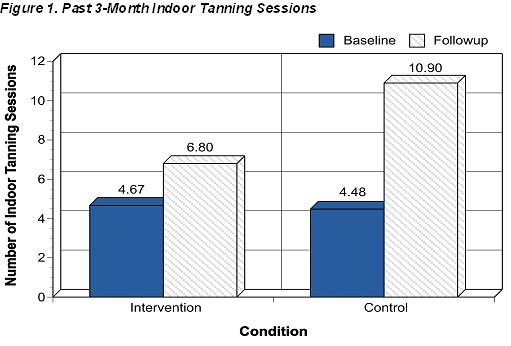Appearance-Focused Intervention
- The evidence is very strong that this type of intervention can be effective in bringing about behavior change.
- The study tested the intervention with 430 female students with ages ranging from 17 to 21 years old from two universities. Inclusion criteria for the study was based on a score of 5 or higher on a 7 point “intent to tan” questionnaire that was sent to a randomly generated list of 1,690 students from the two universities.
- The study measured individuals past tanning bed during the 3 month period of August through October (baseline) and then again at the conclusion of the study for months February through April (follow up). The baseline period contains the months when use was thought to be at its lowest and then compared to the follow up period containing months with the highest predicted use. Figure 1 shows that the control group experienced a much higher increase from baseline to follow up compared with the intervention group. This is strong evidence of the efficacy that an appearance focused intervention can have.

Parent-Focused Intervention
- The evidence shows that this type of intervention can be very effective.
- This study consisted of 469 participants. Included were 234 people in the pre-post intervention condition, 106 in the posttest only condition and 129 participants in the controlled intervention.
- The intervention was given to parents in the experimental group at the beginning of the summer and parents were asked to comment on the materials to ensure they were read. Parents in the control group did not receive intervention materials.
- The study measured sunburn frequency, sunburn severity, and sunbathing tendencies. “Sunburn frequency was measured by asking participants to estimate the number of times in the past 30 days their skin had become red because of sun exposure. Sunburn severity was measured using four items inquiring about the general severity of the sunburn, the degree that the sunburn peeled, pain associated with the sunburn, and the amount of difficulty the child had sleeping because of the sunburn.”

At follow-up, the mean sunburn severity was 1.82 for the intervention group, versus 1.97 for the control group (p<.05).

At follow-up, mean sunbathing tendency was 1.12 for the intervention group, versus 1.49 for the control group (p<.01).”
Community-wide Intervention
- Evidence shows that community-wide multicomponent interventions are shown to be effective.
- The SunSafe project used communities in Vermont and New Hampshire, targeting middle school adolescents for changes in sun-protection. The study measured percentage of body surface covered, percentage of any sunscreen usage, sources of advice of sun protection, and percentage of adolescents’ recall of sun protection advice from adults.
- The average number of different sources of advice about sun protection reported by adolescents at the 2-year follow-up were 1.7 for the intervention group compared with 1.0 for the control group. (p<0.001).
- Recall of advice from school staff had increased from 53% at baseline to 64.3% for the intervention group, while it declined from 55.7% to 14.3% for the control group (p<.001).
- Recall of coach advice increased from 13% at baseline to 20% for the intervention group at 2-year follow-up, while it declined from 16% to 2% for the control group (p<.0001)


